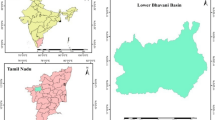Abstract
Rangelands are extensive areas in arid or semi arid regions. They have many uses (e.g. grazing, dry land farming, wildlife habitat, recreation and mining). Generally vegetation is sparse and the principal plant species are adapted to erratic rainfall events. Rainfall use efficiency (RUE) is the quotient of annual primary production divided by annual rainfall i.e. the number of kilograms aerial dry matter produced by 1 ha in 1 year per millimetre of rain. It decreases with increasing aridity. Reasonably well managed arid and semi arid grazing lands are usually in the 3.0–6.0 value range. Available soil moisture is the principal determinant of productivity. The role and significance of the major parameters (rainfall, soil depth, slope and salinity, texture, cover, erosion etc) are considered. Available moisture can be predicted if the appropriate relative productivity indices (RPI) are used in a parametric way. The predictions can be used to classify land according to its capability to support plant growth. Equations have been derived which enable land to be classified on the basis of its potential productivity. Links between land capability and vegetation cover are given.
Similar content being viewed by others
References
Cornet, A. 1983. Utilisation de modeles simples de bilan hydrique et de production de biomass pour determiner les potentialites de production de parcours en zone sahelienne Senegalese. In: Van pract L. (ed) Actes du Colloque tenu a Dakar, les 16–18 Novembre.
Davis, J. G., Scott, A. E. & Kennedy, J. F. 1938. The yield and composition of a Mitchell grass pasture for a period of twelve months. J. Coun. Scient. Ind. Res. Melbourne 11: 127–139.
Easter, C. 1975, Some agronomic factors underlying production on the New South Wales grazing industry. Q. Rev. Agric. Econ. 28: 177–199.
Ebersohn, J. 1979. Herbage production from native grasses and sown pastures in southwest Queensland. Trop. Grassld. 4: 37.
Greacen, E. L. & Hignett, C. T. 1976. A water balance model and supply index for wheat in South Australia. CSIRO Aust. Div. Soils. Tech. Pap. No. 27: 1–33.
Joss, P., Lynch, P. & Williams, O. B. (eds). 1986. Rangelands — A Resource Under Seige. Australian Academy of Science, Canberra.
Keig, G. & McAlpine, J. R. 1974. WATBAL — A computer system for the estimation and analysis of soil moisture regimes from simple climatic data (2nd Ed). Tech Mem Div Land Res. CSIRO No 74/4 45 pp.
Keulen, H.van & Wolf, J. 1986. Modelling of agricultural production: weather, soils and crops. Pudoc, Wageningen.
Hamblin, A., Tennant, D. & Perry, M. W. 1987. Management of soil water for wheat production in Western Australia. Soil Use and Management 3: 63–69.
Lane, L. & Stone, J. 1983. Water balance calculations, water use efficiency and above ground net production. Hydrology and Water Resources in Arizona and the South West 13: 27–43.
LeHouerou, H. N. 1984. Rain use efficiency: a unifying concept in aridland ecology. J. Arid Environments 7: 213–247.
LeHouerou, H. N. & Hoste, C. H. 1977. Rangeland production and annual rainfall relations in the Mediterranean Basin and in the African sahelian and Sudanian zones. J. Range man. 30: 181–189.
Lieth, H. G. & Whittaker, R. H. (eds) 1975. Primary productivity of the biosphere. Springer-Verlag New York pp. 202–215.
Lok, J. J. and Keulen, H.van 1986. Calculation method for regional annual forage availability of natural pastures in the Sahel. CABO Wageningen, 86 pp.
Moss, M. R. 1983. Land processes and land classification. J. Envir. Management 20: 295–319.
Penning de Vries, T. W. T. & Dijiteye, M. A. 1982. La productivite des paturages saheliens. Pudoc, Wageningen.
Reid, G. K. R. & Thomas, D. A. 1973. Pastoral production, stocking rate and seasonal conditions. Quarterly Review of Agricultural Economics 26: 217–27.
Roe, R. & Allen, G. H. 1945. Studies on the Mitchell grass association in south-western Queensland II. The effect of grazing on Mitchell grass pasture. Counc. Sci. Indus. Res. Aust. Bull. No 185.
Steeley, C., Thomas, D. A., Squires, V. R. & Buddee, W. 1986. Methodology of a range resource survey for steppe regions of the Mediterranean Basin. In: Rangelands — a resource under siege, Proc. 2nd International Rangeland Congress Adelaide 1984. Aust Academy of Science, Canberra pp 538–539.
Thomas, D. A., Squires, V. R., Buddee, W. & Turner, J. 1986. Rangeland regeneration in steppic regions of the mediterranean basin. In: Rangelands-a resource under siege. Proc 2nd International Rangeland Congress, Adelaide, 1984 Australian Academy of Science Canberra pp 280–287.
Thomas, D. A. & Morris, J. G. 1973. Soil moisture storage and stock carrying capacity in Pastoral Queensland. Research Report, Bureau of Agricultural Economics, Canberra Australia.
Ting-Cheng, Z., Jiang-Dong, L. & Dian-Chen, Y. 1983. A study on the ecology of Yangcao (Leymus chinensis) Grassland in Northern China. Proc 14th Int. Grassl. Congress. Lexington, Kentucky 1981: 429–431.
Walter, H. 1973. Ecology of tropical and subtropical vegetation. Oliver and Boyd. Edinburgh.
Wijngaarden, W. van 1985. Elephants-Trees-Grass-Grazers. Relationship between climate, soils, vegetation and large herbivores in a semi-arid savanna ecosystem (Tsavo, Kenya). ITC publ, 4 Enschede. pp 159
Williams, O. B. 1974. Vegetation improvement and grazing management. In: Studies of the Australian Arid Zone. II Animal Production (ed A.D.Wilson) CSIRO: Melbourne.
Williams, J. 1983. Soil Hydrology. In: Soils: an Australian Viewpoint, Division of Soils CSIRO CSIRO Melbourne/Academic Press, London pp 507–530.
Wilson, A. D. & Harrington G. N. 1984. Grazing ecology and animal production. In: Management of Australian Rangelands. G.N. Harrington, A.D. Wilson and M.D. Young (eds) CSIRO Division of Wildlife and Rangelands Research.
Yevjevich, V. 1972. Probability and Statistics in Hydrology. Water Resource Publications.
Author information
Authors and Affiliations
Rights and permissions
About this article
Cite this article
Thomas, D.A., Squires, V.R. Available soil moisture as a basis for land capability assessment in semi arid regions. Vegetatio 91, 183–189 (1991). https://doi.org/10.1007/BF00036056
Accepted:
Issue Date:
DOI: https://doi.org/10.1007/BF00036056




